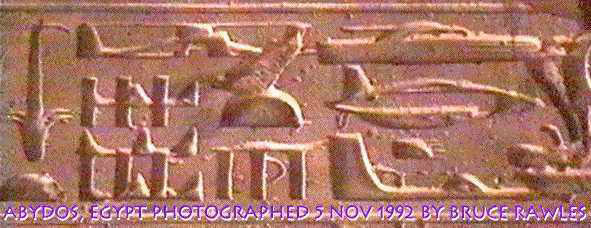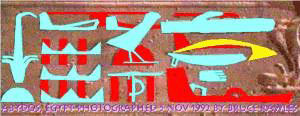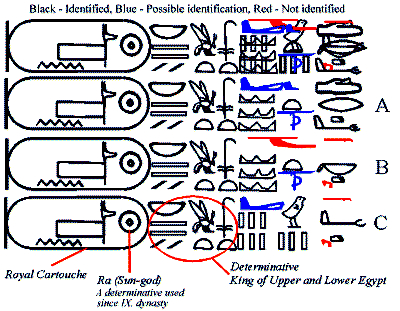|
by Lumir G. Janku 1996 from AnomaliesAndEnigmasLibrary Website recovered through WayBackMachine Website
Is this for real? Yes the picture is authentic.
No post-production manipulations (with an exception of
the line added by the author) or tweaking by graphic manipulation
software.
Sumerian and Indian literature is quite stunning with its descriptions of many devices, going sometimes into great detail, especially in the Indian epics.
Traces of awareness of similar devices are apparent in Greek mythology, or in much earlier Hittite literature, but also in the modern remnants of ancient mythologies, as in the myths of,
...simply wherever you look.
Maybe the
Abydos inscription is, on some deeper level, a type of message
hinting at the uncertainty of our perception of time, with a meaning
we are only able to discern in an archetypal or other sense. But I
would rather leave the philosophical aspects of the inscription
alone for now and try to make sense of it by conventional means.
The two letters are a part of a standard determinative. These two letters mean "king".
On a snapshot taken by Sheri Nakken (although it is not a very clear image), additional glyphs are discernable - the determinative for Lower and Upper Egypt and another determinative followed by a royal cartouche.
The picture I was supplied for use in deciphering the name in the cartouche was a low-resolution image, thus the deciphering of the king's name is not guaranteed, but it seems to belong to Senworsets.
The first symbol in the cartouche was in use since IX dynasty by all kings, and means Ra (the Sun-god). From these glyphs it is fairly obvious that the whole series of glyph is one of the standard laudatory epithets, possibly describing the loftiness of the king.
Not being trained in the "Khemt" language, the deciphering of the meaning of the glyphs is not possible without help from an egyptologist (see a reply from Serge Rosmorduc, an author of a web introduction to Egyptian hieroglyphs).
What I did was to identify the glyphs, trying to match the components of the overlayed glyphs with standard hieroglyphs, as seen in the image on the left. Most of the characters are decipherable easily; there are only a few which are obscured by corrections to such a degree that the identification is not possible without a knowledge of the semantic sense of the inscription.
The part of the glyph on the right side of the original image is unclear. Unfortunately, a part of the stone on which the glyph was made developed a crack and a small piece of it fell off. The symbol is vaguely familiar; possibly I have seen it used on some other inscriptions in the Abydos complex.
I tried to compare it with about 4,800 hieroglyphs in my library, but I was unable to find a close match.
There is one aspect of the inscription which is puzzling.
The temple in Abydos (or Abdjou, as the location was called by Egyptians), is quite a remarkable edifice, especially as far as the quality of glyphs is concerned.
They are all very precise and as far as I can judge, there's no
trace of sloppy workmanship anywhere in the temple, bare the above
inscription. The temple was build by Seti I and finished by
his son, Ramses II, during an era of classical revival. The
obvious corrections on the inscription in question are thus
seemingly out of place. But without the translation of the
inscription, it is difficult to propose a hypothesis for why the
original inscription was changed, apparently twice.
To answer that question, we have to look at numerous enigmatic objects and inscriptions. These are usually interpreted by archeologists in the same way they explain away practically anything which does not fit into preconceived notions about the knowledge base of ancient cultures -- as mere "religious symbolism."
A new look, and a new outlook, may provide future insight into the past.
|


 The
first thing which attracts attention of someone who has studied
Egyptian literature, at least to a degree which enables one to
decipher single hieroglyphs and the meaning of some combinations,
are the two leftmost symbols.
The
first thing which attracts attention of someone who has studied
Egyptian literature, at least to a degree which enables one to
decipher single hieroglyphs and the meaning of some combinations,
are the two leftmost symbols. 